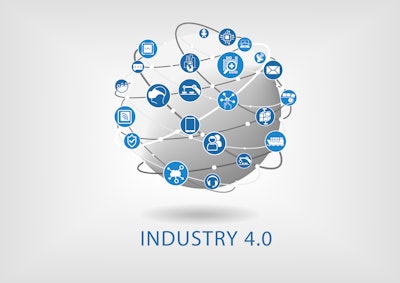
The term Industry 4.0 signifies the computerization of manufacturing as the “Fourth Industrial Revolution.” Coined in Germany, the term has quickly gained traction across manufacturing as the primary descriptor for the increased digitization of manufacturing.
Industry 4.0 has six key design principles:
- Interoperability. The ability of cyber-physical systems, humans and digital factories to connect and communicate via the Internet.
- Virtualization. Monitoring actual processes that take place in the physical factory to create virtual models or simulations.
- Decentralization. The ability of systems within digital factories to make decisions on their own, with no human intervention.
- Real-Time Capability. The gathering of data in each step of the process, including feedback and monitoring, in real time. This is in contrast to legacy systems that tend to “batch process” data, and produce reports that are hours or days old.
- Service Orientation. Offering cyber-physical systems services via an Internet of Services.
- Modularity. Adapting to changing circumstances and requirements.
Why Is 4.0 So Important?
According to a survey by PWC, German manufacturers will invest over $150 billion annually in Industry 4.0 applications. The advantages they’re seeking could include:
- Increased competitiveness: For an industry that has relied heavily on low-wage regions for manufacturing cost reduction, investments in digital technology enable higher wage countries such as Germany to compete with offshore manufacturing hubs for the first time in a generation. This will enable manufacturers to select production locations according to technical capabilities and proximity to consumer demand, rather than decisions driven primarily by wages.
- Increased productivity: With the increased use in automation and in AI systems that can make autonomous decisions, output is projected to increase greatly.
- Increased revenue and profitability: Although the implementation of Industry 4.0 is predicted to require heavy investment by manufacturers, the seamless integration of pre-production (i.e., engineering and design), production, and post-production (e.g., field performance and service) data is predicted to give rise to new revenue opportunities. Additionally, the closed-loop feedback created by this data integration is forecast to increase quality and reduce waste.
- Manufacturing Process Optimization: M2M communications and integrated systems will drive greater collaboration among producers, suppliers, and other stakeholders along the value chain.
- Seamless record-keeping and traceability. Unlike traditional relationships where feedback on products and services takes time to gather, the automated closed-feedback loop is an inherent component of Industry 4.0. The seamless record-keeping enabled by digital systems will speed traceability, while limiting liabilities, warranty costs and recalls.
The first fully digital factories have been implemented by companies who have integrated software platforms that link all aspects of manufacturing, from initial product design to factory layout and manufacturing process optimization to customer feedback after delivery. This integration ties together each aspect of the manufacturing process, and the related software platform.
These software systems do more than trade data. They eliminate many of the mistakes that goes with human-managed production. This next generation of automation is one of the most important drivers behind digital manufacturing and Industry 4.0.
A Real World Example of Eliminating Downtime
Consider this example from 42Q, a cloud manufacturing execution system. In many factories, components, work-in-process (WIP) and finished sub-assemblies have been physically managed on a production floor. Production planners, component buyers and customer service personnel need information about quantity and location, work-in-process and finished sub-assemblies.
Typically, they get this data from a material requirements planning (MRP) system. Using the older MRP model in a batch manufacturing environment, components are issued to production and consumed as products are manufactured.
As the work order progresses in traditional batch manufacturing environments, once components are consumed in production, an operator has to “consume” them in the MRP system, online. This consumption is part of a process called “backflushing.”
Financial statements use the data from this step and production and materials teams depend on this information to manage the production and material supply process.
A common problem is that these transactions can be late, because of the large number of people involved. Production schedulers and planners may think they have enough components to meet production schedules, but they are looking at pre-backflush data.
Using 42Q, one factory automated the backflushing operation and removed the dependency on people, while moving to a real-time data consumption and reporting model. Under the new system, when a product completes automatic optical inspection (AOI), its serial number is sent by the AOI machine to MRP for backflushing.
This eliminates the previous manual communication from the shop floor to the planner, as well as the associated delay and potential errors. In the year before this automated system was implemented, the factory had lost the equivalent of 17 days of production due to inaccurate inventory and WIP data.
For many manufacturers, change equals risk. Disrupting the supply chain or factory lines can cost millions, with untold damage to a brand and a company’s reputation. However, changes are coming, and the widespread adoption of systems and technologies that implement Industry 4.0 is already happening among forward thinking manufacturers.
Srivats Ramaswami, CTO at 42Q, has worked at both OEM’s and contract manufacturers, most recently as vice president of IT Operations. His expertise includes the architecture and implementation of IT solutions, making the global supply chain visible and more efficient. Srivats is now responsible for customer acquisition and engagement, technology development and deployment for 42Q.






















